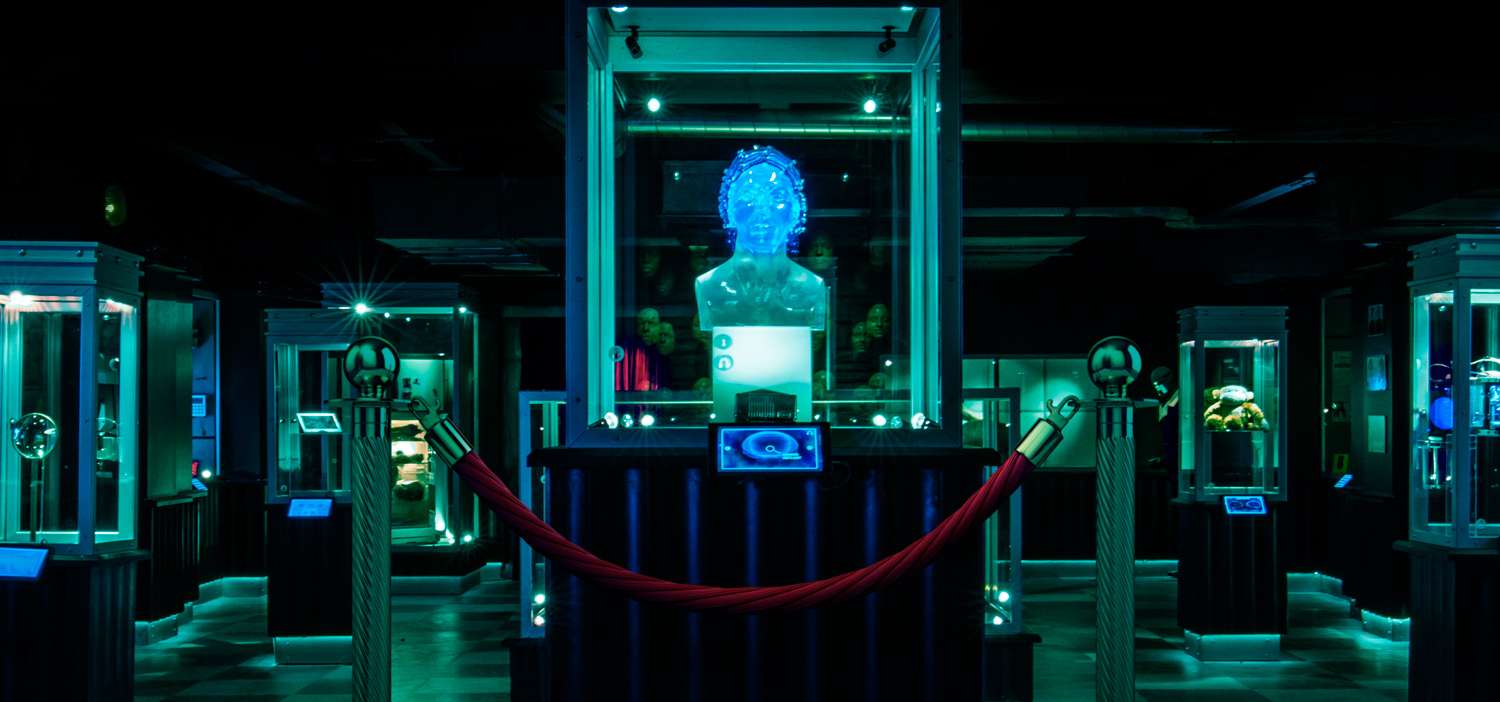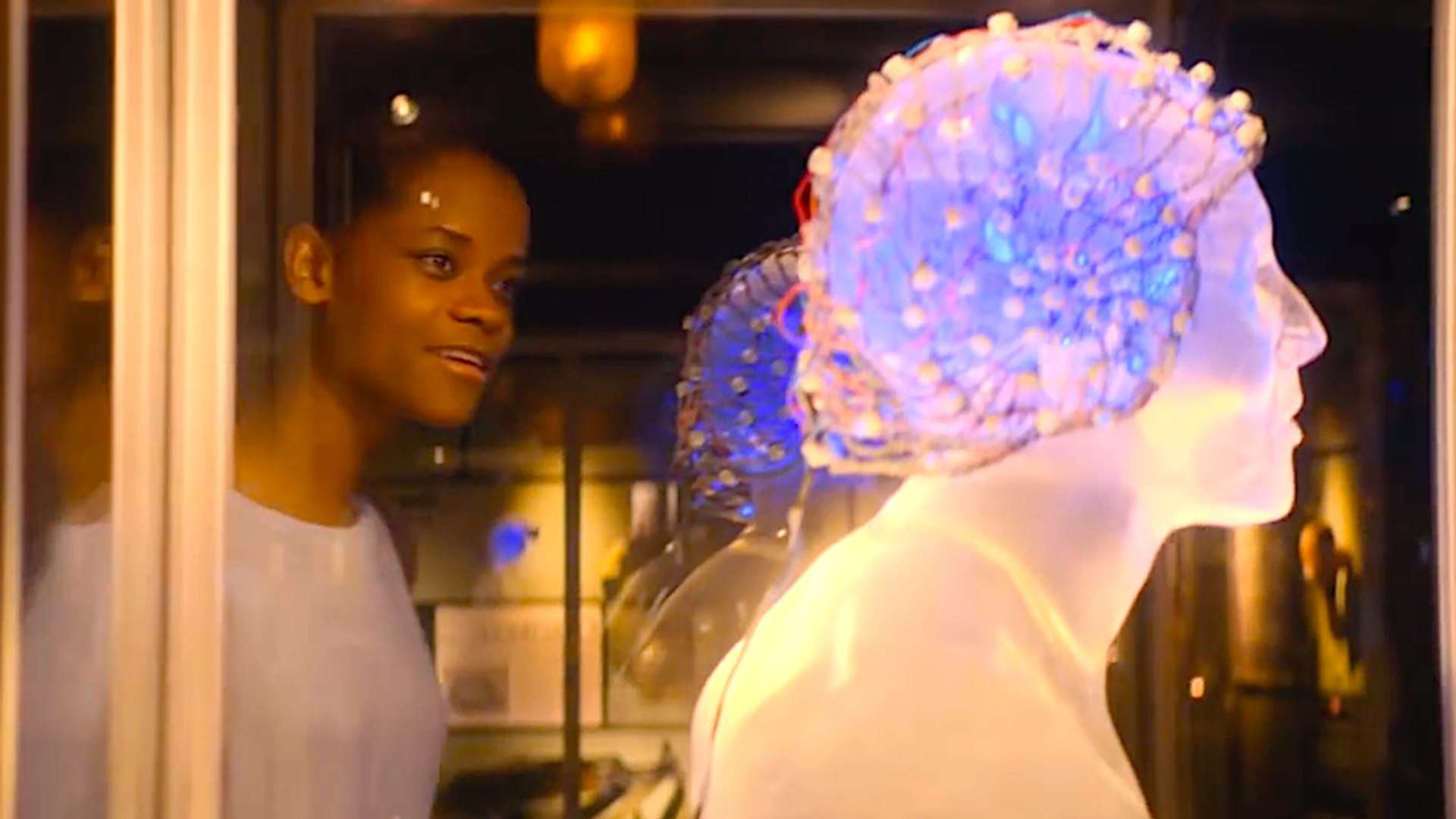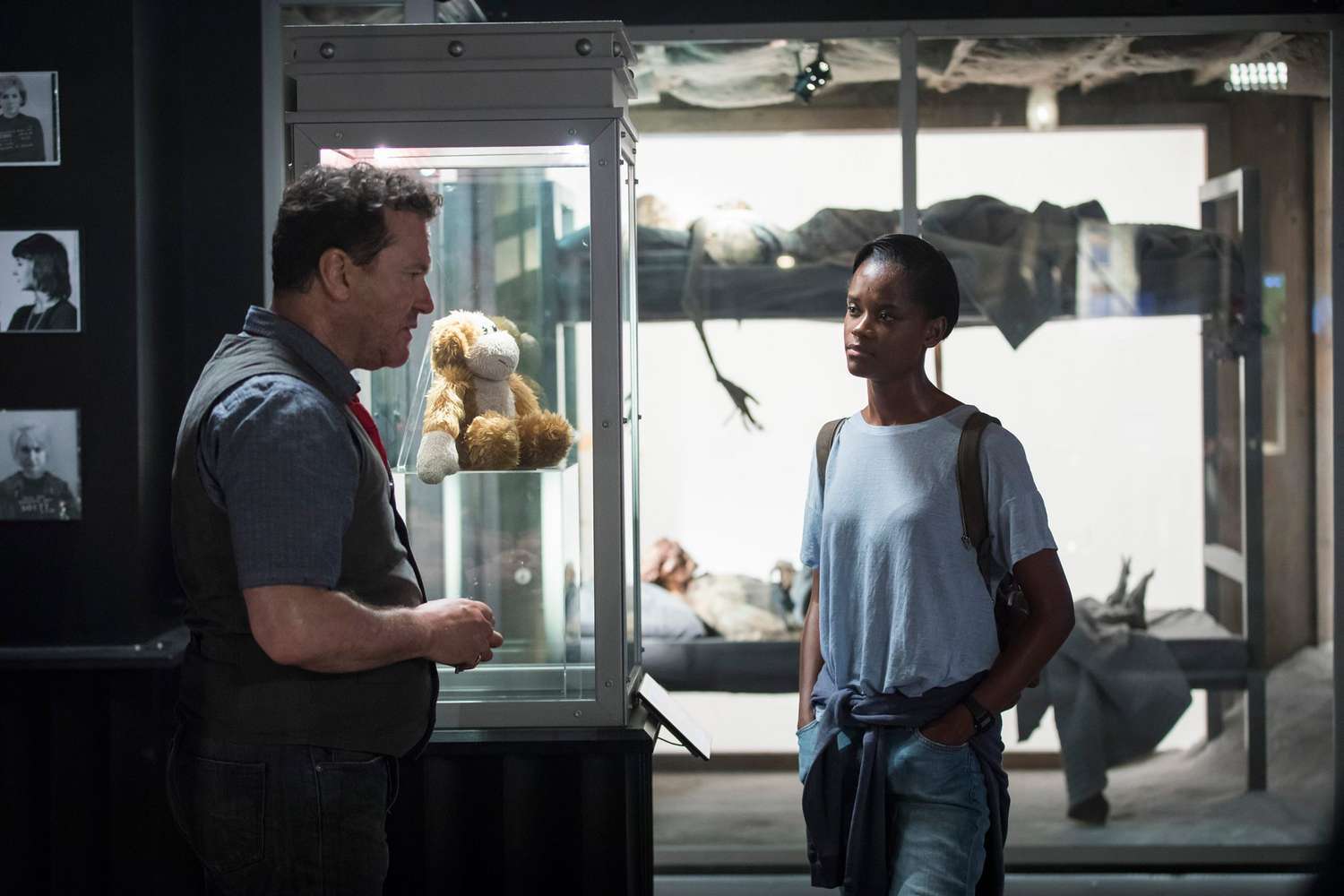Black Mirror (Season 4) Episode 6, “Black Museum,” allows us to connect the dots and deduce that all the stories of all the seasons perhaps have a unified narrative world that reaches its zenith in “Black Museum.” The overarching thematic concern of digitally preserving human minds, which comes with its own set of rights and principles, is echoed intensely in “Black Museum.”
Black Museum” houses easter eggs from nearly every episode that precedes it. Not only the verbal references but the visual references also allow us to situate it as an afterword to the previous seasons. If the mention of Rolo Haynes’ involvement with the TCKR and the repeated references to ‘cookies’ are not enough, there is the smashed iPad from “Arkangel” (Season 4, Episode 2) and the robotic bee from “Hated in the Nation” (03.06). Along with a host of other easter eggs, one cannot help but notice the lollipop from “USS Callister.”
Black Mirror (Season 4) Episode 6 “Black Museum” Recap:
The case of Dr. Dawson
The first artifact that Nish spots is a mesh neural headgear resembling the EEG brain caps. Haynes describes that this one sheds light on how the main exhibit came to be. Through a flashback narrative, we enter into the world of Dr. Peter Dawson, of which Haynes is also a part. In the flashback, Haynes works at St. Juniper’s which fuses business and health care together. At St. Juniper’s, people with no medical coverage sign up for free healthcare in exchange for consenting to occasional medical experiments. Haynes comes across Dr. Dawson, an emergency room physician who is distraught by the death of his patient due to not being able to figure out her ailment correctly. Haynes offers to help him.
Moreover, Haynes offers him the opportunity to participate in applied research that requires him to undergo a neurological implant. In return, this would allow him to experience his patients’ pain without physically bearing the cost of the ailments. This, in turn, would facilitate the correct diagnosis of their ailments by finding out the true source of the ailment. If the headband is slipped on a willing subject, it would absorb their physical sensations and relay them to Dawson’s implant.
What starts as minor fractures soon graduates to major physical injuries and late-stage terminal diseases. Haynes calls the device ‘Dawson’s symphatic diagnoser.’ When Dawson figures out that his implant could act equally well with pleasurable sensations, he starts using it anomalously while having sex with his partner. This way, he cannot only feel the pleasure of his own orgasm but also that of his girlfriend simultaneously.
However, when one day, a patient dies due to being poisoned while wearing the headgear. Dawson, too, experiences death but comes out unharmed. This majorly affects his implant, with the line between pleasure and pain being severely compromised. Dawson starts deriving pleasure out of his patient’s pain. His sexual encounters with his girlfriend, albeit with the headgear on, digresses to a highly sadomasochistic zone. Soon, Dawson starts interfering in normal open-and-shut medical cases to buy time so that he can derive pleasure from the ailment.
Dawson, by now, has become an addict. When an old woman flatlines due to Dawson’s immoral act. “She flatlines in front of him, and he is like an alcoholic, watching someone pour a glass of good scotch down the sink, sick at the waste of good shit,” Haynes notes of Dawson’s perverted devouring of the old lady’s tryst with death. Dawson is jettisoned, and Haynes promises him that they will eventually figure a way out to pull back the transplant, although he shows no sign of doing it anytime soon.
With no work and no partner, Dawson begins deriving pleasure from self-mutilation. However, he never experiences the kind of pain that he had once felt while self-flagellating, as he always reaches a limit. Most importantly, his awareness that he is in a safety net and would not harm himself to the point of death interdicts the fear response in the amygdala. When Dawson experienced his patients’ wide range of pain, it was the fear that always complemented the pain. Haynes says, “You can inflict pain on yourself but not terror.” Thus he lurks in the dark, looking for his prey, from whom he can feed off. He finds a homeless man, plunges a drill into his forehead with the headgear on, and kills him. When the police find him, he is wearing an ecstatic smile and later slips into a vegetative state.
The ‘love-struck’ couple
The second artifact, an innocuous-looking plush monkey toy, begins the second narrative. At a party, a couple, multiracial at that, has casual sex. The woman, Carrie, gives birth to a baby boy, and the three become a family unit. However, their domestic bliss is not long-standing as the woman is mowed down by a car in a freak accident, and the doctor declares her to be comatose. She only responds through a rudimentary “comm box” that only allows her to answer “yes” or “no” to questions. Haynes meets her partner, Jack, and explains that TCKR, the institution for which he works, is working on digitally extracting a consciousness out of the brain and rehousing it in a different brain.
He further explains that the human brain uses only about forty percent of its capacity, the rest lies unvacated, “like an empty Airbnb”. Haynes puts forth an offer to Jack, he offers to fit Carrie’s mind into the unused space of Jack’s brain. This way, she would be alive again through Jack and would feel the range of sensations as experienced by Jack’s physical sensorium. Jack, who is still in love with Carrie, does not take too long to accept the offer and allows Carrie’s presence in his mind as a sort of ‘hitchhiker.’ The dangers of the procedure and its possible aftereffects are, as usual, obliterated. Haynes even endows it with a charitable touch by offering to donate the organs of Carrie’s original body as a way of giving back to the community.
Soon, the harmony between the partners is sent into a downward spiral as Carrie, unable to operate on her own, starts criticizing Jack’s every move. It is not too long before Carrie becomes a persistent nuisance, one that has to be tamed by threatening to consume food that she hates. Particularly distressing are the times when Carrie starts nagging as Jack, now long-single, shows sexual interest in other women. Jack goes to Haynes looking for help in limiting Carrie’s access to his mind. Haynes offers an upgrade that will give Jack the power to put Carrie on ‘pause’ whenever he deems fit. Soon, the pause privilege is exploited to shun her out for several weeks.
As Jack gets into a new relationship with his new neighbor, he, along with his new partner, feels it unnecessary to have Carrie reside in his head. However, bound by his responsibilities towards his son, Jack does not agree to a full deletion of Carrie as that would mean killing her ethically. With the help of Haynes, Carrie is transferred to a stuffed monkey toy, through which she regresses to the previous state of her communications with the world via the rudimentary form of contact, which only allows either a yes or a no. Even that state of a pure negative ‘no’ is taken away, as the monkey has only two recorded utterances– “Monkey loves you” and “Monkey needs a hug.”
The child soon grows tired of playing with the monkey and throws it away, suspending Carrie into a hellish state of neither being alive nor fully dead. It is found that Carrie is still trapped inside the monkey as Haynes takes it out of its glass case. There is no way for her deletion now, as the UN Convention on the ethical use of cookies made it illegal to transfer human consciousness into limited formats like this.
Consciousnesses are only allowed to be transferred into devices that allow the expression of at least five emotions. It is because of this monkey that Haynes is fired from TCKR, and he has no other option than to set up this Black Museum in the middle of nowhere. Perhaps the ‘black’ is an epithet that stands for the blotch that developed on his reputation due to his involvement in all these crimes.
The final cookie:
In the final narrative, we finally venture past the curtain to see the main attraction. Haynes tells Nish that after TCKR jettisoned him, his interest diverted towards capturing celebrity consciousnesses, preserving the holograms of famous people after they died. As celebrities became unreachable, Haynes became particularly interested in convicted killers.
In the flashback, we see that this is when Haynes reaches Clayton Leigh, a man who has already appeared in the background details of the other two micronarratives due to his alleged crime. Leigh innocently asks Haynes if he can prove his innocence through the use of technology, but Haynes has a sinister motive. Leigh does not need much convincing after Haynes tells him that he needs to sign over the rights to his digital self, or cookie, in exchange for a transfer of the lion’s share of the profit to his family that would sustain them after he is sent to the electric chair.
However, believing that Leigh has no one to back him up, Haynes concocts a false story that Leigh’s family discarded him as soon as he is indicted of the crime. Contrary to Haynes’ narrative, the flashback shows his wife being concerned about this purported charitable act of transfer of rights in exchange for the maintenance benefit. Leigh consoles his wife, still holding on to the hope that if his pardon comes through, it would not even matter, but if he is sent to the chair, this is going to pay his family. When the execution day arrives, his consciousness is carefully captured.
Clayton is born again as his cookie is confined in the Black Museum. Haynes does not just stop at putting the cookie of Clayton Leigh in a confined glass cage. He quickly figures out how to turn him into a pleasurable attraction from just a plain miraculous spectacle – by allowing people to pull the lever and watch Clayton being electrocuted in the chair as many times as they wanted. What’s more, the tourists can even take back home a hologram of Leigh’s torture, a conscious sentient snapshot of Leigh embedded in a keychain as a souvenir.
However, the secret is never letting Leigh be on the receiving end of anything beyond 15 seconds of maximum voltage, as that would wipe him out, thereby killing him. Initially, it becomes difficult to hold everyone in due to the volume of people that turned in for the sheer vicarious thrill of watching a ‘brutal killer’ being executed innumerable times.
Before Haynes can finish, he is debilitated by a bout of violent coughing, and Nish takes over the story. Nish asks him to narrate that part which he has carefully obliterated, the part where his wife started a protest campaign to absolve his name and got some momentum behind it. Nish says the protests, along with a documentary on Leigh, hurt the footfalls in the museum. It was no longer the fun family crowd and regular tourists populating the place hereafter but only the murkiest of the demographic– the perverts, the fascists, and the sadists– that lurked around.
Haynes even allowed them to torture Leigh’s cookie longer than the maximum set limit in exchange for fat wads of notes. Clayton’s cookie was not the same after all the prolonged torture either, and soon he became catatonic. There was no fascination left as pulling the lever on a catatonic Leigh was akin to pulling the lever on an unresponsive vegetable. When Leigh’s wife arrived, she was aghast at the site of her husband and unable to come to terms with his state, she killed herself.
Black Mirror (Season 4) Episode 6 “Black Museum” Ending Explained:
How does Nish invade the Black Museum?
Soon, Nish allows her faux Brit accent to fall apart, and we realize she is not a random tourist. Her motives are far more defined than just loitering around the place, looking at objects that pique her interest randomly. Nish reveals her true identity– she is indeed the daughter of Clayton. It was Nish, a tech-savvy herself, who played around with the air conditioning system of the whole place, causing it to malfunction. She purposely did it to make the place hotter as that would allow her to offer water to Haynes that she had spiked with poison.
Haynes, who was being slowly poisoned by Nish through the water to this point, is debilitated to the point where Nish does not have to force the neural implant into his head but simply inserts it. By killing Haynes, Nish transfers Haynes’ consciousness inside the mind of Leigh’s cookie, exactly as was the case with Carrie. He is transferred to the execution exhibit, which, in short, would house a double-decker mercy-killing. “My daddy’s giving you a ride,” says Nish, drawing on the passenger/hitchhiker analogy of the ‘Carrie’ story. She hacks into the system of the exhibit, lifting the maximum voltage limit, in order to free her father.
She allows the voltage to run higher than the previous limits and bids her father goodbye. Nish, too, gets a souvenir. However, for Nish, the souvenir is not that of Leigh but of Haynes, captured broiling in devilish agony for eternity. Nish holds the monkey with Carrie tight and lets it watch the execution. She then gets out of the museum, fudges the air conditioning unit so that a shortcircuit builds up, and paces towards her car with the monkey while the entire building is engulfed in fire.
As Nish starts her car, in conclusion, we see that, in fact, this system of digital consciousness transference is not unknown to Nish as she, too, is housing a passenger in her mind– her mother. Finally happy by her daughter’s revenge and additionally being able to perceive it all through her senses, the mother looks on as the daughter drives away.
Black Mirror (Season 4) Episode 6 “Black Museum” Final Note:
“(There’s) Always Something There to Remind Me”
The film ends with replaying the song– “(There’s) Always Something There to Remind Me,”– which marked Nish’s entry, and we finally pay attention to the pun, the one that was communicated to us in the beginning, but we were not better equipped to understand its significance. “How can I forget you when there is always something there to remind me?” is actually a metaphor for the entire consciousness transference procedure. Interestingly, even when Haynes begins the narration of his Carrie story, he begins by running the idea of the state of being infatuated through the audience’s mind (“You ever had those relationships where you just can’t get someone out of your head?”) as the development for what seems to be a normal romance story.
It is not long before we understand that the line was actually inviting attention to its literal meaning. Then there’s also Jack’s comment at his bewildering state, “She is running through my head like a goddamn tune that I can’t shake.” The episode takes the seemingly romantic utterances and prises them open to deflate the romantic undertones so that we pay more attention to how nefarious things can be when they are taken as it is.











